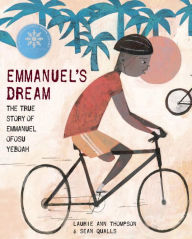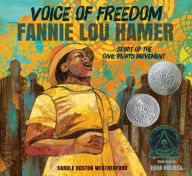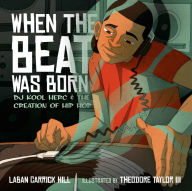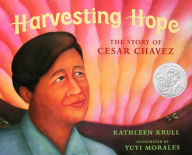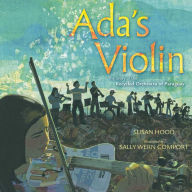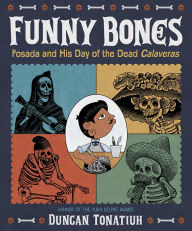Girls cannot be drummers. Long ago on an island filled with music, no one questioned that rule—until the drum dream girl. In her city of drumbeats, she dreamed of pounding tall congas and tapping small bongós. She had to keep quiet. She had to practice in secret. But when at last her dream-bright music was heard, everyone sang and danced and decided that both girls and boys should be free to drum and dream. Inspired by the childhood of Millo Castro Zaldarriaga, a Chinese-African-Cuban girl who broke Cuba's traditional taboo against female drummers, Drum Dream Girl tells an inspiring true story for dreamers everywhere.
The New York Times Book Review - Maria Russo
Engle's poetic narrative combines with López's warmly ethereal folk-art illustrations to evoke a nighttime tropical dreamscape.
Publishers Weekly
01/19/2015
A riot of tropical color adds sabor to the tale of Millo Castro Zaldarriaga, a Chinese-African-Cuban girl who dreams “of pounding tall conga drums,/ tapping small bongó drums/ and boom boom booming/ with long, loud sticks/ on big, round, silvery/ moon-bright timbales.” Everybody in Cuba believes that only boys should play the drums, and her own father forbids her to perform, but the “drum dream girl” (as she’s referred to throughout) finds her own drums, practices, and persists until her father relents and hires a teacher. Lopez’s (Tito Puente, Mambo King) paintings fuse dream and reality as the girl flies through the air, drumming on the moon and making music with butterflies and birds; Engle’s (Silver People) lines dance with percussive sound words and rhythmic repetition. Though an afterword reveals that Zaldarriaga later became famous enough to perform for Franklin and Eleanor Roosevelt, Engle focuses on her initial struggles rather than her subsequent career. A valuable addition to the growing library of stories about strong Latina women. Ages 4–8. Author’s agent: Michelle Humphrey, Martha Kaplan Agency. Illustrator’s agent: Stefanie von Borstel, Full Circle Literary. (Mar.)
From the Publisher
2017 Carnegie Medal winner
• "A beautiful account of a young girl's bravery and her important contribution toward gender equality in the creative arts."—Kirkus, starred review
• "The heroine’s tenacity in the face of naysayers will inspire all dreamers, and the illustrator’s smile-inducing cameo on the last page emphasizes the universality of Millo’s story...For those looking for more nonfiction titles about female musical powerhouses."—School Library Journal, starred review "The text and illustrations work together beautifully here, creating a story that will imbue readers with inspiration and a yearning to make music of their own."—Booklist "A valuable addition to the growing library of stories about strong Latina women."—Publishers Weekly "With its emphasis on artistry and visual metaphor, this title bears a strong kinship with Yuyi Morales’ Viva Frida, but it also brings an accessibility that young viewers (and teachers) will appreciate."—Bulletin "Engle’s poetic text takes its cues from Zaldarriaga’s chosen instrument, its rhythm at times steadily assured and at others loose and improvisational...[E]very spread is full of motion, with some of the illustrations requiring a ninety-degree turn, as if the book itself has got to dance."—Horn Book Magazine "Engle's poetic narrative combined with Lopez's warmly ethereal folk-art illustrations to evoke a nighttime tropical dreamscape."—New York Times Book Review
Children's Literature - Jean Boreen
Inspired by the true story of Cuban drummer Milla Castro Zaldarriaga, one of the first female drummers in Cuba, this beautifully illustrated book tells the story of a girl who hears her own music added to the drumbeats of others. As she continued her informal education listening to all of the drumbeats that surrounded her in her island home, the drum dream girl continues adding her own imaginary music until, finally, her older sisters ask her to join their new all girl band. Their father insists that this is impossible, but seeing her determination tells her that he will find a teacher and if that teacher discovers the girl’s skills acceptable, she can play the drums. Impressed with her talent, the teacher provides her even more instruction and eventually encourages her to play at a local café. The patrons are impressed and decide that all girls and boys in their island nation should be encouraged to play the drums. The text and the brilliantly colored illustrations are a perfect match. This book is a beautiful and thoughtful addition to any library. Reviewer: Jean Boreen, Ph.D.; Ages 6 to 10.
School Library Journal
02/01/2017
Gr 1–4—The award-winning Cuban American author has made her mark on children's literature with her powerful portrayals of little-known aspects of Cuban history, often shedding light on the Afro-Cuban experience. This work is inspired by the childhood of Millo Castro Zaldarriaga, a Chinese-African-Cuban girl who broke down traditional taboos against female drummers. López's luminous illustrations represent the island's diversity. Details of Cuba's and the protagonist's Chinese, African, Taíno, and Spanish roots are interwoven into the lyrical narrative and the vibrant acrylic paintings.
Kirkus Reviews
★ 2014-12-06
Pura Belpré winner and Newbery honoree Engle, known for writing free-verse historical fiction, introduces readers to Millo Castro Zaldarriaga with this illustrated poem, inspired by her subject's childhood. Millo became a world-famous musician at quite a young age. Before fame, however, as Engle's account attests, there is struggle. Millo longs to play the drums, but in 1930s Cuba, drumming is taboo for girls, "so the drum dream girl / had to keep dreaming / quiet / secret / drumbeat / dreams." This doesn't stop Millo; she dares to let her talent soar, playing every type of drum that she can find. Her sisters invite her to join their all-girl band, but their father refuses to allow Millo to play the drums. Eventually, her father softens, connecting her with a music teacher who determines that her talent is strong enough to override the social stigma. The rhythmic text tells Millo's story and its significance in minimal words, with a lyricism that is sure to engage both young children and older readers. López's illustrations are every bit as poetic as the narrative, a color-saturated dreamscape that Millo dances within, pounding and tapping her drums. Though it's not explicit in the text, her mixed Chinese-African-Cuban descent is hinted at in the motifs López includes. A beautiful account of a young girl's bravery and her important contribution toward gender equality in the creative arts. (historical note) (Picture book. 3-8)
Read More

